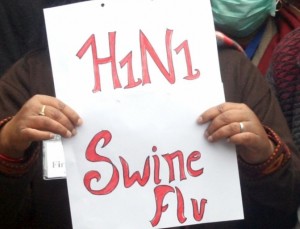 KOLKATA—India is struggling to contain a wave of swine flu. The death toll has surpassed 1,500 since the infection took hold in mid-December.
KOLKATA—India is struggling to contain a wave of swine flu. The death toll has surpassed 1,500 since the infection took hold in mid-December.
About 26,000 people have tested positive for the virus, and health officials say infections are continuing to spread as current unseasonal rains and high humidity that allow the virus to thrive.
Indian health ministry officials said this week that they are cooperating with state governments to better combat the H1N1 virus. The ministry has asked the states to study the patterns of the infection and mortality rates, to devise a better strategy.
Health care experts complain that poor infection prevention measures are driving the surge of H1N1 cases across the country, and that delays in diagnoses are also contributing to the rise in the death toll.
Half of the swine flu deaths in the past three months have occurred in western states of Gujarat and Maharashtra, and in the past week the first cases of H1N1 were reported in the remote northeastern states of Nagaland and Manipur, which border Myanmar.
2009 outbreak
The last major outbreak of swine flu was in 2009, when surfaced in Mexico and spread around the world, becoming a pandemic. About 2,700 people died in India during that outbreak.
The flu, which according to scientists is a novel mix of pig, bird and human genes, is now circulating seasonally across many countries. Last year India registered 218 deaths because of swine flu, down from 699 in 2013.
As World Health Organization notes that number of H1N1 cases in India has been unusually high, the Indian health care experts blame the spurt in the infection to the absence of public awareness of swine flu.
Dr. Abhijit Mukherjee, a pediatrician in Kolkata says by following better hygiene with some simple precautionary measures the swine flu infection could be thwarted in a large way.
“People should use surgical or specified N-95 masks, if they cannot avoid public transports, parties, markets and other place which are crowded,” he said.
“Just by washing hands with soap and water and alcohol-based hand sanitizer one can cut down the risk of infection of H1N1 virus to a pretty good extent. Most people are not following such simple hygiene basically because they are not aware of this,” Dr Mukherjee told VOA.
He urged authorities to launch a public health awareness campaign to teach prevention measures and stop the spread.
Harbored originally in pigs, the H1N1 strain of virus is usually transmitted by inhaling contaminated droplets ejected by a sick patient’s coughing or sneezing, or by touching contaminated surfaces.
The symptoms caused by the H1N1 strain of the flu initially include high fever, chills, headache, sore throat, runny nose, headache and fatigue, which are often confused with those of ordinary flu.
Shortage of anti-viral drugs
Local media reports in parts of India say pharmacies are running low on anti-viral drugs Oseltamivir and Tamiflu, which are being currently used to treat the H1N1 infection.
But India’s health minister J. P. Nadda said there is no need to panic – there are medicines and facilities in place to address the problem.
But many people say tests for swine flu at private diagnostic centers are too expensive. Tests at special labs through government hospitals are free of charge, but high demand has prolonged the wait for results, in some cases up to one week.
Some doctors are calling for special flu-treatment facilities and an increased number of testing centers.
Dr. Arindam Kar, chief of critical care at Medica Superspeciality Hospital, a private hospital in Kolkata said ideally patients should start receiving treatment within 48 to 72 hours of infection.
“The government should set up some specified flu-clinics where the patients themselves suspecting that they have the symptoms of the flu or after being referred by doctors can land as soon as possible,” Dr. Kar said.
While the infections and deaths have been under scrutiny in India’s news media, other doctors say the spread is likely to wane in the coming weeks, as outdoor temperatures rise.
“Flu-season usually starts with the fall in temperature in the beginning of the winter, and ends as the summer sets in. I think, soon the rage of the swine flu will begin tapering off in India, at least for this season,” Dr Mukherjee said.
